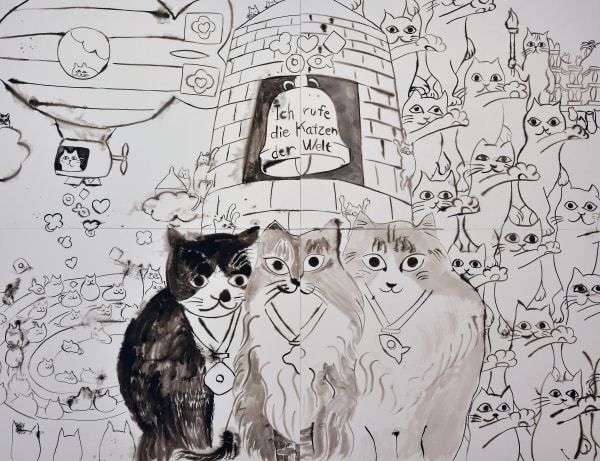Ota Fine Arts Shanghai is delighted to present "Desert Garden", a group exhibition featuring eight artists from China, Japan, Korea and Singapore. Through the diversity of works presented, the exhibition hopes to create a new landscape, a possible horizon, and a place of beauty and imagination.
¥ouada's (b.1987) whimsical cactus-shaped sculptures are made of expanding foam, used mineral bottle and coke cans, and beer cans that he has re-fashioned from soft drink cans. Similar to ¥ouada's paintings, these works are a re-creation of objects that are familiar and reminiscent of his youthful days, invoking feelings of nostalgia. Their inviting pastel colors give the illusion that it is safe to approach only for audiences to realize that coated black thorns are dangerously strewn across the work. Elsewhere, Nobuaki Takekawa (b.1977) addresses weighty issues with the affectionate visual language of animals and the Olympic Games global event. Takekawa creates an opportunity for viewers to look at the frenetic global event as a platform for the human race to challenge its own limits, as a unifying occasion and yet also as an event that reveals complex underlying issues in society. Embedded in their works are a sensitivity to subtle socio-cultural shifts, provoking deeper considerations.
Akira the Hustler (b. 1969) is an artist who is active in championing social issues and is motivated by discriminatory social happenings. In this exhibition, he expresses his determination by rallying the masses behind his beliefs. As he sets the blaze aflame in "Bonfire", he breaks down the barriers of closed and alienated communities, gathering people with differences around a central flame. Jong YuGyong's (b.1991) practice stems from his exploration of North Korea, Japan and South Korea to find where he stands amidst their differentiated yet conjoined histories. In his painting series "For One and Only Country", Jong dissolves the ideological notions of North Korea's propaganda by enlarging the original images, adding visual noise and distorting the compositions. Black circles and bright colors proliferate the canvas, with references made to Pop art. Yet, behind the lively image lies Jong's struggle with his identity as a "Zainichi" -- a person who is treated as neither Japanese nor Korean. As Akira and Jong seeks to voice out their thoughts, audiences are privy to the struggles and power of their dialogue.
Etsu Egami (b.1994) graduated from the Central Academy of Fine Arts, China and studied under established Chinese artist, Liu Xiaodong. With her bold brushwork in pastels and grey hues, her distorted human portraits reveal intricate facial expressions and the uniqueness in every individual's facial make-up. Through trial and error, Etsu hopes to discover the gaps in this increasingly digitalized and virtualized world, to highlight the differences between reality and reception; what is being depicted and what is received. In "Untitled", Zhou Yilun (b.1983) has reduced human figures and objects of the original pictures to color blocks and lines. A lingering sense of eeriness accompanies this dark and thought-provoking image but gives its audience no clue as to what it may or may not represent.
"We Feast On Love Lost" is an early work by Singapore artist, Guo-Liang Tan (b.1980). Tan has referenced images of traditional still life online, and by removing the flowers from their original containers, has displaced them from their original context. He invites us to re-look at the notion of the painted surface and the condition of painting. Flora continues to present itself in "toononefurino nanamematsu". With contrasting colors and multi-fold lines, Masanori Handa (b.1979) creates a pictorial landscape that is inspired by atmosphere, climate, psychogeography and fleeting encounters.
Ota Fine Arts Shanghai invites you to join us for a unique sensory experience as we navigate the arid complexities in a "Desert Garden"; to experience the heat and struggle of Akira and Jong, the beauty of flora and fauna blooms in Tan and Handa's works, the polished ruggedness of ¥ouada and Takekawa, and finally, the grey and misty hues found in Etsu and Zhou's works.
Overview
Works
Installation Views
Join our mailing list
* denotes required fields
We will process the personal data you have supplied to communicate with you in accordance with our Privacy Policy. You can unsubscribe or change your preferences at any time by clicking the link in our emails.







